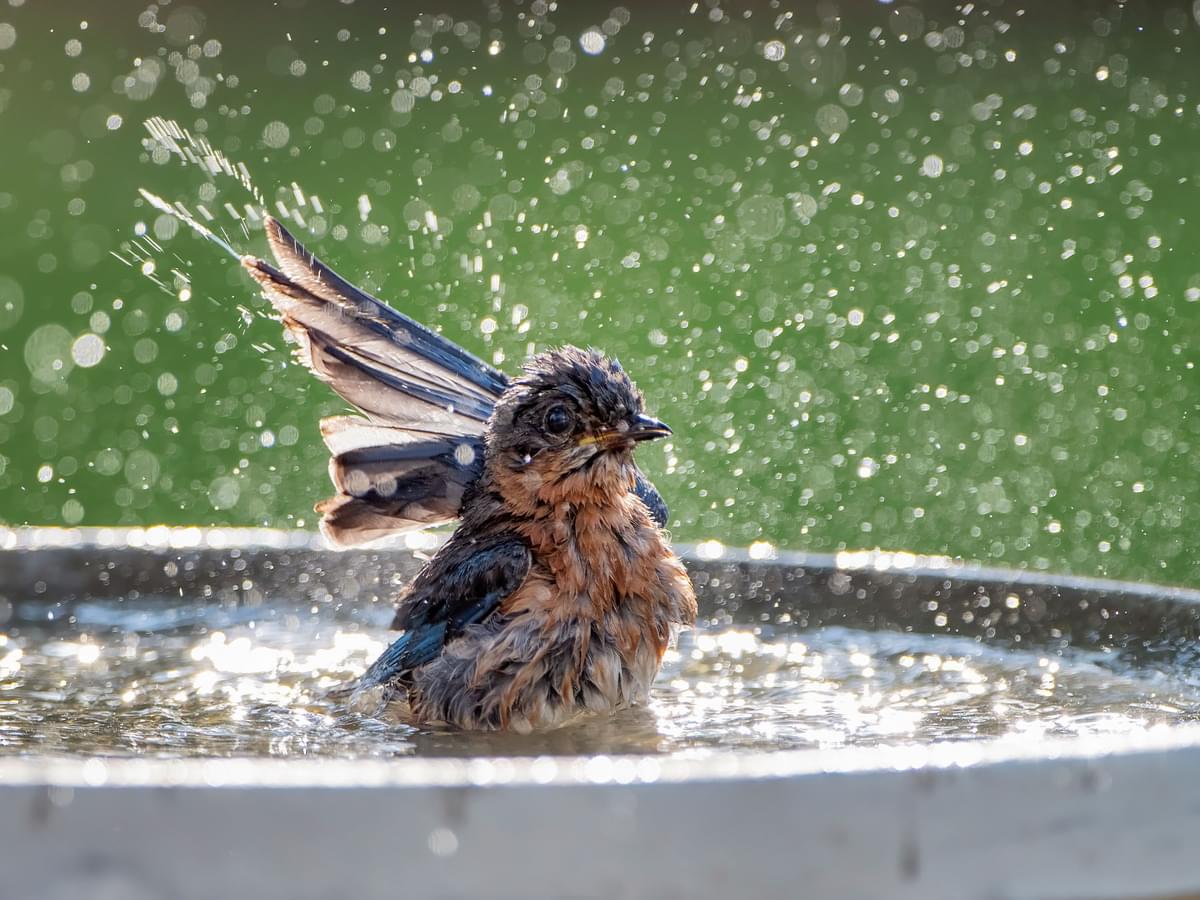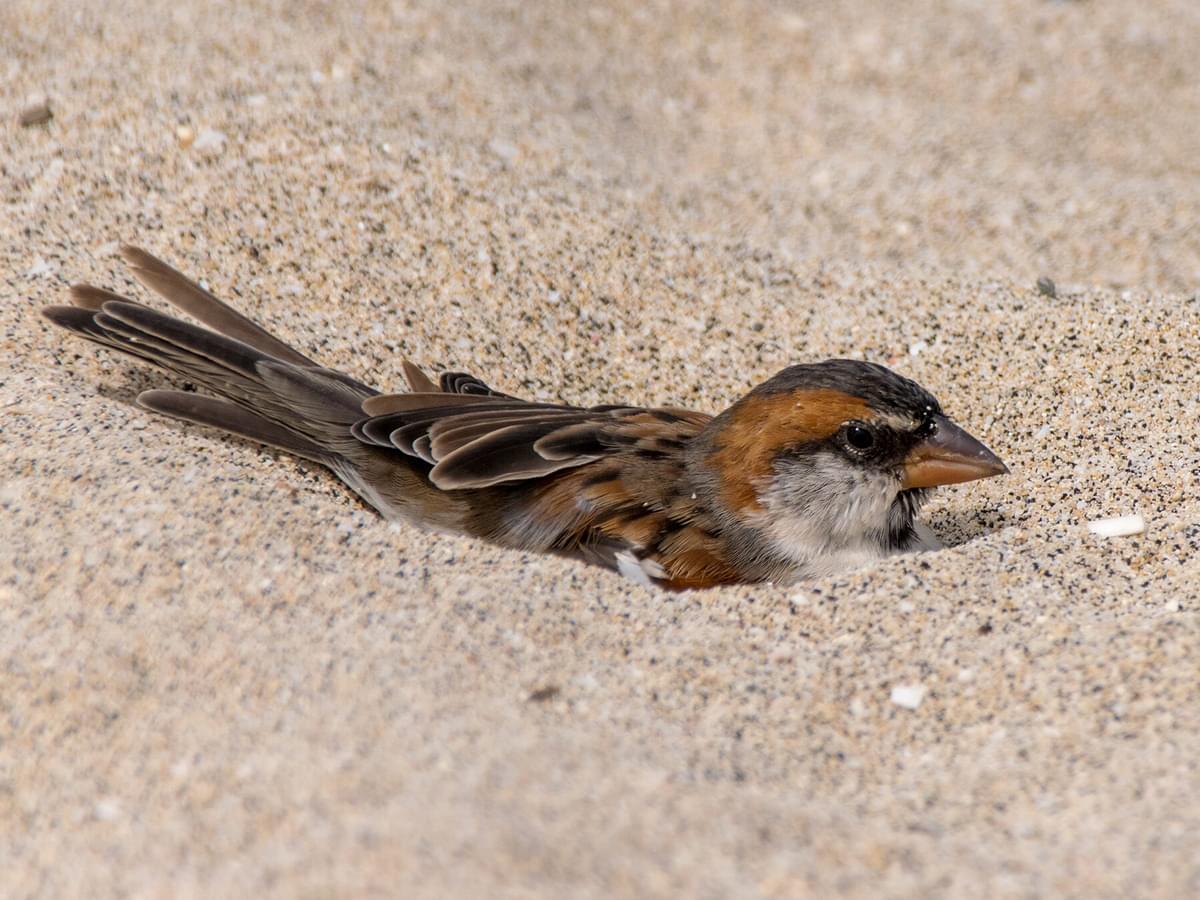Bathing Behaviors

Together, bathing and preening form the regular grooming routines of birds around the world. Below, we’ll be looking in greater depth at the first part of their hygiene regime – bathing behaviors – so keep reading to learn more.
Splish, Splash, Taking a Bath
One of nature’s biggest fans of bathtime, flamingos spend up to 30 percent of their day bathing and preening, gracefully slipping beneath the surface of a shallow pool or lagoon, and creating a spray of water droplets as they emerge, and then repeating the process again and again. Not all bird species follow such an elaborate or noteworthy bathing display, but for all species, it’s necessary to keep their feathers as dirt-free as possible.
Birds have evolved to keep themselves clean and their plumage well maintained, developing a range of well-practiced techniques to rid their feathers of the dust, dirt and damage caused by daily life. Dirt-free feathers are vital to all aspects of a bird’s life, including regulating their temperatures, being able to fly and keeping healthy.

An American Flamingo - Flamingos spend up to 30 percent of their day bathing and preening
A Dive into Bathing
For birds, bathing does not always mean taking a quick dip in a bird bath or puddle. Read on to learn more about the different methods birds around the world use to keep their feathers in tip-top condition.
Wings in the Water
Birds have evolved to use a variety of different approaches to keeping themselves clean, dictated by the resources they have available in their local environments. For some species, a dip in a pool, puddle or bird bath offers the ideal opportunity to refresh their feathers, while others may rely on alternative techniques such as dust baths or rain bathing to cleanse their plumage.
Bathing is vital for birds as it allows them to keep their plumage in top condition:
- Feathers that are coated in dirt particles become ineffective at keeping birds insulated against cold or wet weather.
- Waterlogged or dirty feathers can impair a bird’s ability to fly smoothly.
- Feathers that are not regularly maintained run the risk of becoming riddled with parasites, which can damage their overall health and wellbeing.
In summer, birds can frequently be observed bathing in cold water as a way of cooling down on hot days.
Bathing across Biomes
In regions with little rainfall, birds take a rather imaginative approach to bathing, using dust or sand to coat their feathers, soaking up any excess preen oil and then shaking vigorously, resulting in a thorough clean.
Where lack of rainfall isn’t an issue, some birds rely on the wet weather as a natural shower, soaking up the raindrops and expelling excess moisture before recoating their feathers in preen oil. For others, it’s enough to rub against dew or rain that has pooled on the surfaces of leaves or other foliage, using this water to clean their feathers. In snow-covered landscapes, birds have no choice except to bathe in ice.
In busy cities, opportunities for bathing may be limited due to dense human habitation and a lack of natural water sources. City life can be potentially hazardous for bathing birds, with the presence of predators, particularly domestic cats, looking to take advantage while birds might be less vigilant than usual. Hazards also exist in the form of polluted waterways and unsafe bathing sites, which may pose a risk of drowning.

A Somali Ostrich - In regions with little rainfall, birds take a rather imaginative approach to bathing, using dust or sand to coat their feathers
Types of Bathing Behaviors
Where possible, birds will seek water to bathe in, taking advantage of pools, ponds, puddles or bird baths. In rainy regions, regular bathing is no problem, and many birds enjoy a spot of rain-bathing to refresh their plumage. But not everywhere on Earth enjoys abundant rainfall.
Read on to find out more about the different bathing behaviors of birds around the world.
Dust Bathing
How do birds keep their feathers clean where water isn’t readily available? Well, one fairly common method is by having a ‘dust bath’, which may initially sound like a rather strange way to refresh a plumage, but stay with us…
In arid regions, it’s not unusual to spot Sparrows, Wrens, Thrushes and Thrashers wallowing in shallow dusty hollows on the ground, while actively applying the dust particles so that their feathers are coated. This process helps to maintain the desired amount of preen oil on a bird’s feathers.
Dust-bathing birds create a hollow by scraping their feet on the ground and shaping it into a dip. The bathing process that follows may include vigorous rolling, flapping, fluffing and shaking of the bird’s body and wings.
Once finished, the newly dusted bird often flies to a nearby branch, where it continues to shake any excess dust particles from its body. Excess oil is absorbed by the dust and then shed, along with any unwanted dirt, dead skin or debris.
Rain Bathing
Not all birds are anatomically designed for dipping into water or wading into puddles. Instead, many birds with particularly short legs, including Nuthatches, Woodpeckers and Treecreepers, engage in ‘rain bathing’ to thoroughly cleanse their feathers whenever possible.
Once rain starts falling, they simply perch in the upper branches of trees, or on exposed telephone wires and fluff out their feathers so that as much of their surface area as possible gets soaked, then shake off the excess water in a vigorous display, before letting their widespread wings dry out in the sun that follows, and preening their newly cleansed feathers.

A Sparrow taking a dust bath

A Fiery Throated Hummingbird 'rain bathing'
Dipping and Diving
Where a suitable water source is available, dipping and diving into pools or ponds for a thorough wash is the preferred bathing approach of many bird species.
Swifts and Swallows spend much of their lives on the wing, and bathing is no exception. It’s definitely an ‘on-the-go’ affair, as they swoop down to skim the surface of a lake or river and then spray water over their bodies by fanning out their tail as they rise to the skies.
Chickadees, Buntings, Wrens and Water Thrushes are more fans of the submersion approach, darting into a pool or puddle, submerging themselves beneath the water’s surface, and then spreading their wings and tails as wide as possible, shaking off excess fluid and repeating the process several times until they are suitably refreshed.
Robins, Thrushes, Jays and Mockingbirds take a progressive approach, gradually submerging themselves a little bit deeper into a pool, puddle or bird bath, flicking water over themselves with their wings and rolling their breast beneath the water's surface to ensure water penetrates through the densest areas of feathers. They then fluff their feathers and shake off any excess droplets until their plumage is cleansed and free from dirt or dust.
Ducks, Swans and Geese will preen while swimming on the water’s surface, but will also dive below for a fuller bath, preening their wet feathers as they travel across a pond or lake. Water Rails, Gulls and many shorebirds wade into shallow water, dipping their head and wings and then rapidly flicking off any excess moisture before preening themselves repeatedly.

An Eurasian Jay - Where a suitable water source is available, dipping and diving into pools or ponds for a thorough wash is the preferred bathing approach of many bird species
The Rituals of Bathing
Bathing for birds can be just as important socially as for hygiene purposes. If you are able to observe birds regularly dipping into a pool or bird bath, you may begin to notice certain rituals or repeated behaviors that they practice every bath time to keep themselves safe and as clean as possible.
Read on to learn more about the rituals and safety precautions of bathing birds.
Feathery Frolics
Where there’s one bathing bird, the chances are there are more gathering for their own turn to take a dip. Sparrows, in particular, tend to form a rowdy bunch around the edges of a bird bath, noisily squabbling as they flutter into and out of the water.
Starlings are also frequent communal bathers, and although there is no conclusive research as to why they are fans of bathing en-masse, being part of a flock at a bird bath may offer a sense of security and defense against predators.
After bathing, many birds follow a series of ritualistic steps to expel any moisture, shaking their tail, vibrating their wings and fluffing out their feathers. Following this, they will usually fly off to a perch to begin preening, applying preen oil to their feather shafts and across their plumage, to ensure it retains its insulating properties.
Some birds, including Cormorants, spread their wings for lengthy periods post-bathing, drying their feathers in the sun before beginning their preening regime.
Safety Soak
Bathing birds may be less alert or wary than when simply foraging or perching. When sitting in a bird bath, it’s important to choose a location with good all-round visibility so birds are safe when concentrating on the important task of self-grooming.
While half-submerged in a puddle or shallow pool, birds are particularly vulnerable to predators and can be caught off-guard by a cat lurking nearby.
It’s also vital that bird baths are regularly cleaned to avoid the spread of disease between avian bathers, and cleared from debris, such as fallen leaves, to make sure no impurities are applied to their feathers.

Cormorants spread their wings for lengthy periods post-bathing, drying their feathers in the sun before beginning their preening regime
Implications of Bathing
The benefits of bathing in birds extend way beyond their superficial appearance. Read on to find out just how important a healthy plumage is to other aspects of a bird’s health, life and general well-being.
Plumage Perfection
A healthy, well-maintained plumage is crucial to so many aspects of a bird’s life. Clean feathers are not only vital to temperature regulation and energy-efficient flight but healthy, vibrant plumage plays a role in camouflage effectiveness and the ability to display impressively enough to find a mate during the breeding season.
Dirty, broken feathers and plumage that is waterlogged stained with dust or overloaded with parasites are more likely to lead to a lower chance of survival in the wild.
Keeping Parasites at Bay
Bathing is essential for birds to cleanse their feathers from any lice, mites or other parasites, helping to maintain optimum health and the ability to function effectively. A heavy parasite load can lead to infections that can quickly spread to other birds nearby.

A female Northern Cardinal - A healthy, well-maintained plumage is crucial to so many aspects of a bird’s life
Summary
For birds, bathing is not a part of their daily grooming routine they can afford to skip. In order to ensure their feathers are healthy and clean and can offer protection against poor weather, birds need to remove dirt, dust and excess oils regularly.
Lack of water is no excuse, with desert-dwelling birds using dust baths as an effective alternative to a good soak in a puddle or a bird bath.
Once bathing is complete and a bird’s plumage is suitably refreshed and dirt-free, they are then able to move on to the equally essential process of preening, which can take between 10 and 25 percent of their daily time budget.
